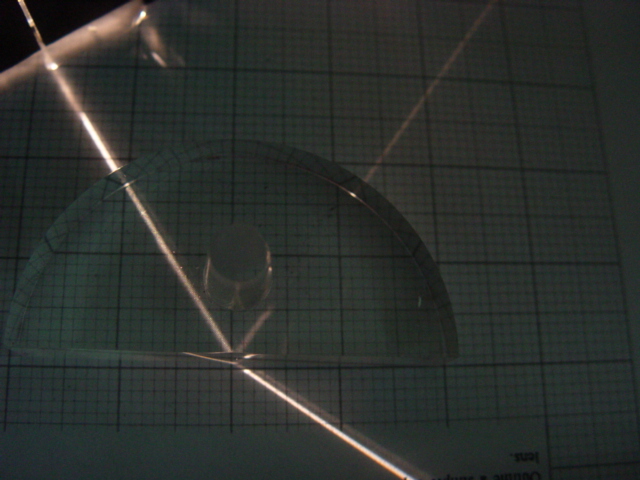
The ray doesn't bend on the way in, it is at 90 degrees to the glass surface. It turns away from the normal on the way out, as it speeds up. It obeys Snell's law in this case.
4B 23/03/09
Holiday HW - Finish my 2 sets of Qs on em waves. We watched a vid on the most important challenge facing humanity at present.
EM waves.
We finished the mid year. The we did some stuff on electromagnetic waves.
We went through the mid-year test up to Q8.
The semi circular glass block experiment shown below.

The ray doesn't bend on the way in, it is at 90 degrees to the glass surface. It turns away from the normal on the way out, as it speeds up. It obeys Snell's law in this case.
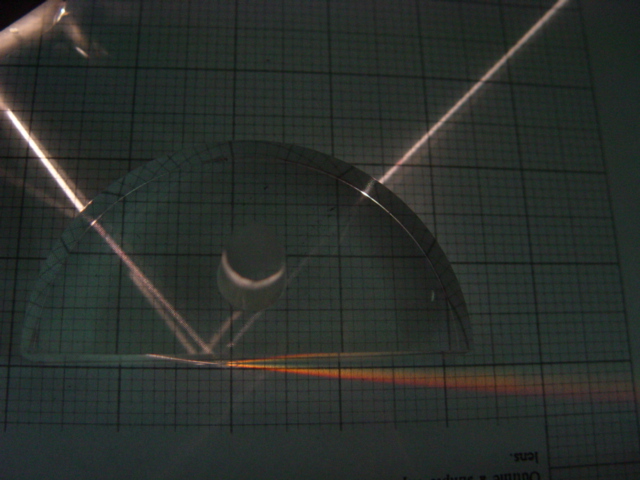
As the angle increases, the ray is refracted nearer to the glass surface and is split into a coloured spectrum and a weak reflected ray appears.

Above a certain angle, the critical angle (about 42 degrees for glass) all of the ray is reflected back. This is called total internal reflection
HW Complete the experimental worksheet for the experiment including plotting the sin graph. If you didn't get results for the semicircular block, use these. i = 10, 20, 30, 40 r = 11, 25, 42, 65. The critical angle was 42 degrees or so so bigger angles than this totally internally reflected and didn't obey Snell's law. Complete the critical angle equation set of calculations too.
We looked at an adaptation of the Snell's law equation for the specific case when light is shining out of a more optically dense material at its critical angle.
The critical angle is the angle of incidence at which total internal reflection first occurs.
This set of calculations are the HW ones.
"Going through" the mid year. RTQ.
The rest sat their midyears. The others of you made some notes on the electromagnetic spectrum - our next topic.
The rest sat their midyears. The others of you made some notes on the electromagnetic spectrum - our next topic.
Simple Snell's law calculations
We looked at calculations involving the simplified version of Snells law that you are required to know for IGCSE. This set of calculations was attempted.
Why does mass increase as you approach the speed of light? Think.
It doesn't really. Not if measured in a frame of reference that is moving along with the particle in question. If both time and distance are dilated when observing a moving object (which explained why magnetic forces are just electrostatic forces for charges moving with respect to each other) then quantities such as kinetic energy and momentum will also start playing silly buggers.
Remember - those who haven't yet will sit the mid year on Monday.
11 non-Geographers sat the mid year assessment.
Mid year test for 10 of you....
I told you the topics to revise for the mid-year, which will take place next double lesson. Those that miss it will do it the week after.
HW Well, revise clearly.
We looked at an adaptation of the Snell's law equation for the specific case when light is shining out of a more optically dense material at its critical angle.
The critical angle is the angle of incidence at which total internal reflection first occurs.
This set of calculations was attempted.
Then I told you the topics to revise for the mid-year, which will take place next double lesson. Those that miss it will do it the week after.
HW Well, revise clearly.
We looked at calculations involving the simplified version of Snells law that you are required to know for IGCSE. This set of calculations was attempted.
P98 Q4 a and b only
We introduced the formula: Wavespeed = Frequency*Wavelength
The fire alarm kind of wrecked the following experiment.
An experiment was carried out to see how much rays of light bent when they passed into a glass or perspex block. Rays were found to always bend towards the normal line (90 degrees from the glass surface) when they entered the block. This bending is called refraction. It happens because the light changes speed as it enters the perspex block.
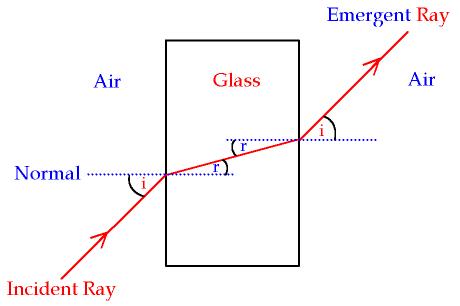
There was a mathematical relationship between the angle of incidence (angle between ray on the way in and the normal) and the angle of refraction (angle between the ray inside the block that has changed direction and the normal)
sin i was proportional to sin r as shown by the graphs you plotted.
sin i / sin r (the gradient of the graph you plotted) gave us an idea of how much perspex bent light. This is a property of the perspex known as its refractive index, n. Our answer was about 1.4. This means that light travels 1.4 times slower in perspex than it does in air. (air hardly slows down light at all - it has a refractive index of very slightly over 1)
The relationship between sin i and sin r is dependent on the refractive index of the materials involved. You need to be able to use the formula to do calculations.
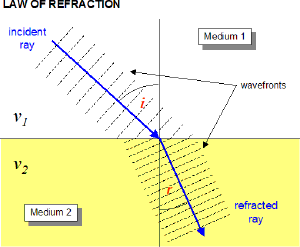
The more optically dense material reduces the wavelength of the light, slowing it down and changing its direction.
HW Just P107 Q1. We'll have to sort out the expt. next Monday.
We looked at a wave tank demonstrating the 3 main properties of waves, reflection, refraction and diffraction.
Here is the website with the cracking animations giving examples of all of these effects
Reflection: Waves reflect off plane surfaces at an angle which is equal to their angle of incidence.
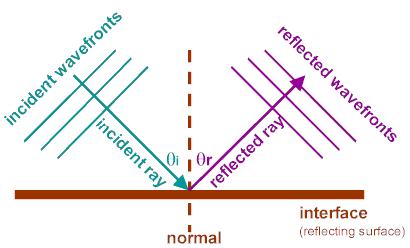
Refraction: Waves change direction when they enter a medium which slows them down. The wavelength is reduced, not the frequency.

Diffraction: Waves spread out when passing through a gap. The smaller the gap, the more spread out the waves become. If the gap is much larger than the wavelength, then diffraction less noticeable.
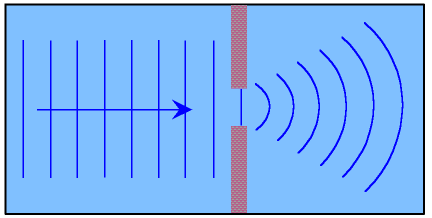
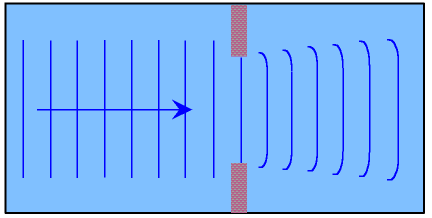
HW Complete short notes with a diagram on reflection, refraction and diffraction (use the book or the website.) You can hand your books in along with all the other catch up below if it is needed next time.
P107 both Qs 1 + 3 must be completed (catch up) as must the 6 website questions below if not handed in today.
1. Make a sketch of a wave showing the amplitude and wavelength.
2. If the period of a wave is a) 0.1s and b) 0.25s what is the frequency?
3. A railway carriage is 28m long. 10 carriages pass you in 10s. How fast is the train going?
4. 5 waves pass you in 20s. The wavelength is 7m. What is the wave speed?
5. A radiowave has a frequency of 200kHz and a wavelength of 1500m. What is it's speed?
6. Another radio wave has a frequency of 600kHz. Calculate the wavelength.
We redid the 2 experiments on refraction that you probably did in the 3rd form. Both experiments showed Snell's law in action.
An experiment was carried out to see how much rays of light bent when they passed into a glass or perspex block. Rays were found to always bend towards the normal line (90 degrees from the glass surface) when they entered the block. This bending is called refraction. It happens because the light changes speed as it enters the perspex block.

There was a mathematical relationship between the angle of incidence (angle between ray on the way in and the normal) and the angle of refraction (angle between the ray inside the block that has changed direction and the normal)
sin i was proportional to sin r as shown by the graphs you plotted.
sin i / sin r (the gradient of the graph you plotted) gave us an idea of how much perspex bent light. This is a property of the perspex known as its refractive index, n. Our answer was about 1.4. This means that light travels 1.4 times slower in perspex than it does in air. (air hardly slows down light at all - it has a refractive index of very slightly over 1)
The relationship between sin i and sin r is dependent on the refractive index of the materials involved. You need to be able to use the formula to do calculations.

The more optically dense material reduces the wavelength of the light, slowing it down and changing its direction.
The second experiment was the semi circular glass block experiment shown below.

The ray doesn't bend on the way in, it is at 90 degrees to the glass surface. It turns away from the normal on the way out, as it speeds up. It obeys Snell's law in this case.

As the angle increases, the ray is refracted nearer to the glass surface and is split into a coloured spectrum and a weak reflected ray appears.

Above a certain angle, the critical angle (about 42 degrees for glass) all of the ray is reflected back. This is called total internal reflection
HW Complete the experimental worksheet for both experiments including plotting the sin graphs for both. If you didn't get results for the semicircular block, use these. i = 10, 20, 30, 40 r = 11, 25, 42, 65. The critical angle was 42 degrees or so so bigger angles than this totally internally reflected and didn't obey Snell's law.
I appear to have got it wrong, we have already recapped waves and the wavespeed formula, including the information below.
Waves transport energy from one place to another with no overall movement of matter. The energy is transported as vibrations (a combination of KE and PE) through some medium.
Waves come in 2 major types, transverse and longitudunal.
In transverse waves, vibrations occur which are perpendicular to the direction in which the wave is travelling. e.g. water waves, light.
Longitudunal waves have vibrations which are parallel to the direction of wave travel.
This site has excellent animations of the various types of waves.

transverse above

and longitudinal
Important quantities that you need to remind yourself of are:
1. Amplitude - the maximum "height" of the vibration. Easy to see in a transverse wave, not so easy in a longitudunal.
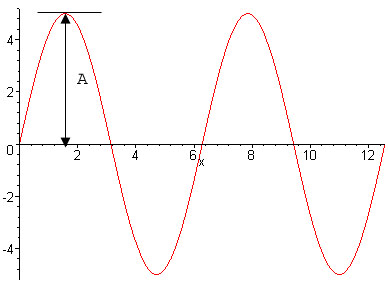
2. Wavelength - The distance from the peak of one wave, to the peak of the next. It can really be measured from any point on the wave, to the next equivalent point.

3. Frequency - the number of waves which happen per second (measured in Hz)
Related to the frequency is the Period (T) which is the time taken for one wave to happen.
We did some questions on waves which can't of done any harm I'd say.
HW Answer the following questions on waves:
1. Make a sketch of a wave showing the amplitude and wavelength.
2. If the period of a wave is a) 0.1s and b) 0.25s what is the frequency?
3. A railway carriage is 28m long. 10 carriages pass you in 10s. How fast is the train going?
4. 5 waves pass you in 20s. The wavelength is 7m. What is the wave speed?
5. A radiowave has a frequency of 200kHz and a wavelength of 1500m. What is it's speed?
6. Another radio wave has a frequency of 600kHz. Calculate the wavelength.
We went through the electric test.
We started to recap waves. This was a large topic in the 3rd form, but it is necessary for you to kmow a bit more this time around.
Waves transport energy from one place to another with no overall movement of matter. The energy is transported as vibrations (a combination of KE and PE) through some medium.
Waves come in 2 major types, transverse and longitudunal.
In transverse waves, vibrations occur which are perpendicular to the direction in which the wave is travelling. e.g. water waves, light.
Longitudunal waves have vibrations which are parallel to the direction of wave travel.
This site has excellent animations of the various types of waves.

transverse above

and longitudinal
Important quantities that you need to remind yourself of are:
1. Amplitude - the maximum "height" of the vibration. Easy to see in a transverse wave, not so easy in a longitudunal.

2. Wavelength - The distance from the peak of one wave, to the peak of the next. It can really be measured from any point on the wave, to the next equivalent point.

3. Frequency - the number of waves which happen per second (measured in Hz)
Related to the frequency is the Period (T) which is the time taken for one wave to happen.
HW Q1 on P81 only.
You sat the electric test.
We went through the test.
Then we started to look at ways that waves can change direction.
We looked at a wave tank demonstrating the 3 main properties of waves, reflection, refraction and diffraction.
Here is the website with the cracking animations giving examples of all of these effects
Reflection: Waves reflect off plane surfaces at an angle which is equal to their angle of incidence.

Refraction: Waves change direction when they enter a medium which slows them down. The wavelength is reduced, not the frequency.

Diffraction: Waves spread out when passing through a gap. The smaller the gap, the more spread out the waves become. If the gap is much larger than the wavelength, then diffraction less unnoticeable.


HW Q1+2 P82
We sat the test!
At home, electricity is supplied as alternating current. This happens because the current is being pushed by an alternating voltage. Electrons actually go backwards and forwards within the wires 50 times a second.
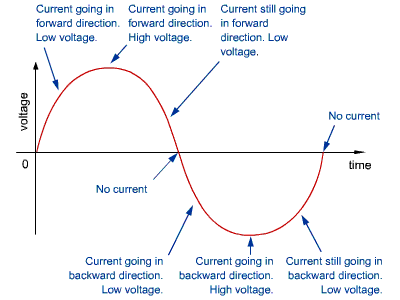
We also wired some plugs. A fuse is a fire prevention device - it stops large currents flowing accidently causing heating which might start a fire.
We saw where the fuses actually go. They are put into the plug of a device attached to the "live" pin.
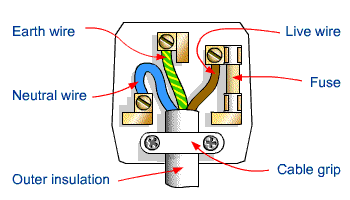
The other 2 pins of a plug are the neutral and the Earth. The live and the neutral connection are the 2 that join the circuit in normal operation (just like connecting to both ends of a battery really.)The Earth pin is a safety measure which stops the outer case of an electrical device becoming charged by the live wire accidently. If ever the live wire were accidently to touch the outer case, a large current would flow down the Earth wire and the fuse would melt. This is described well on the BBC website here
We tried to wire some plugs ourselves, some of you are much better than me at it. Others may need to practise a bit before doing it for real....
HW Revise for a test on all of electricity (including static) next time. Use some of the giant sets of Qs I have given you as practice. I'll also take in the 3 sides which were due in today after the test.
We saw a video on household electrical safety.
Lots of revision on electricity was done, doing various GCSE questions. We may have just touched on the new topic - waves.
Revise for a test on the whole of electricity, including electrostatics.
For various reasions, you won't have ansother lesson for a while.
We are going to cover household electricity
I order to do this we introduced the electrical power formula.
Power (Watts) = Current (Amps) times Voltage (Volts)
P = IV
I = P/V
V = P/I
We'll move onto household electricity and electrical safety next time.
Diodes only allow current to pass through them in one direction. They are normal conductors, obeying Ohm's law in one direction but they have a huge resistance in the opposite direction, not allowing current to flow.
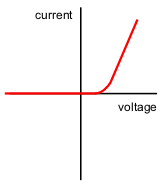
Read here if interested how they work.
HW a) Notes on Diodes in book b)Read through Chapter 5 and attempt P49 Q 1 + 2
We started looking at electricity in the home.
At home, electricity is supplied as alternating current. This happens because the current is being pushed by an alternating voltage. Electrons actually go backwards and forwards within the wires 50 times a second.

We also wired some plugs. A fuse is a fire prevention device - it stops large currents flowing accidently causing heating which might start a fire.
We saw where the fuses actually go. They are put into the plug of a device attached to the "live" pin.

The other 2 pins of a plug are the neutral and the Earth. The live and the neutral connection are the 2 that join the circuit in normal operation (just like connecting to both ends of a battery really.)The Earth pin is a safety measure which stops the outer case of an electrical device becoming charged by the live wire accidently. If ever the live wire were accidently to touch the outer case, a large current would flow down the Earth wire and the fuse would melt. This is described well on the BBC website here
We tried to wire some plugs ourselves, some of you are much better than me at it. Others may need to practise a bit before doing it for real....
HW Not until next time, after your IGCSE English exam.
We are going to cover household electricity
I order to do this we introduced the electrical power formula.
Power (Watts) = Current (Amps) times Voltage (Volts)
P = IV
I = P/V
V = P/I
We'll move onto household electricity and electrical safety next time.
HW P49 Q1 only!